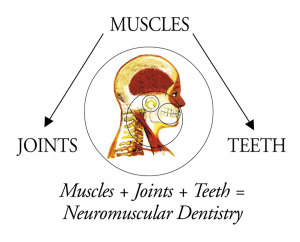NEUROMUSCULAR
DENTISTRY

Neuromuscular dentistry is the area of dentistry that focuses on the correct alignment of your Temporomandibular (jaw) joint and its surrounding muscles. If this joint is out of alignment, it can cause pain when speaking, chewing or making facial expressions. This painful condition is known as Temporomandibular Joint Disorder (TMD).
If you believe your jaw joint is misaligned, neuromuscular dentistry can help alleviate your painful symptoms.
About TMDA misaligned bite, called a malocclusion occurs when you jawbone and skull do not properly line up with each other. This unbalanced bite continually strains your muscles, which are constantly working to achieve a functional bite. This strain can cause a number of problems including:
- Jaw, neck and facial pain
- Blurred vision
- Soreness in your face
- Ringing in your ears
- Headaches and migraines
- Insomnia
- Dizziness
- Shoulder and back pain
- Jaw popping
- Lockjaw
- Loss of feeling in your arms
- Chipped teeth, bruxing (grinding), clenching
These symptoms do not develop overnight. TMD is a chronic degenerative condition that typically takes years to develop. Unfortunately, many TMD sufferers are unable to identify the cause of their condition because the symptoms can be caused by many other factors.
Technology for TMDOur Doctors are trained to determine if your symptoms are caused by a misaligned bite using advanced technology, such as:
Panoramic and cephalometric X-ray – These are used so that all angles of your teeth and jaw can be seen.
Treatment Options for TMDOnce Our Doctors have determined you need neuromuscular dental treatment, they will discuss your options for treatment, including:
- Orthodontics
Braces and Invisalign work by repositioning your teeth to place your jaw in an optimal position. - Coronoplasty
This procedure reshapes your tooth enamel to permanently correct your bite. - Restructuring
By using crowns to raise your teeth, the restructuring procedure can also permanently realign a bad bite.
Some patients may find relief from their TMD with dental orthotics. These resemble a mouth guard and are worn at night, but some may be required to be worn much more than that. While they have been compared to mouth guards, you can also think of dental orthotics as a splint. The dental orthotic will train your jaw to relax in a more natural position. This may eventually eliminate or significantly lessen pain and discomfort you feel with TMD.
While some orthotics are removable, others are fixed. Fixed orthotics are bonded to your upper or lower arch when the opposing arch is getting restored to its proper function.
Each dental orthotic is customized to fit your unique bite. You must wear your dental orthotic for the length of time instructed by Our Doctors. By removing the orthotic, or not wearing it when you should, you risk your jaw moving back into the position it was, which will bring back the pain.
